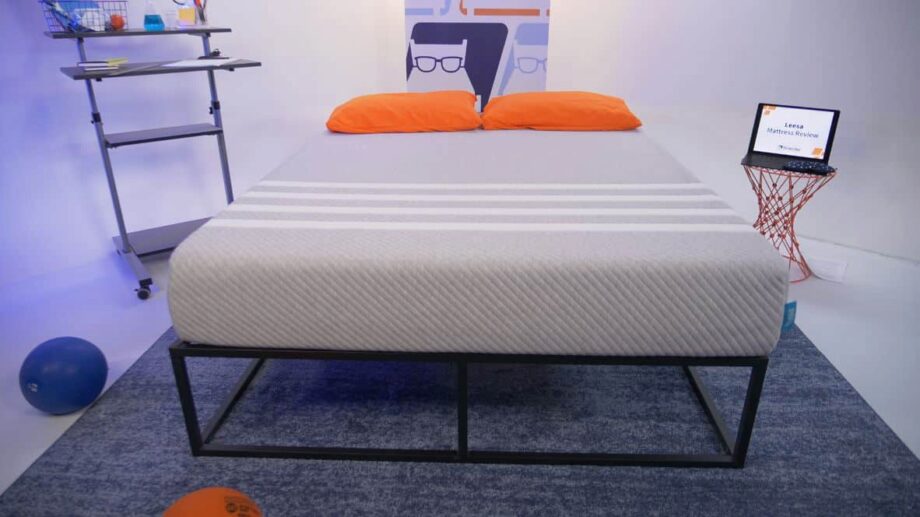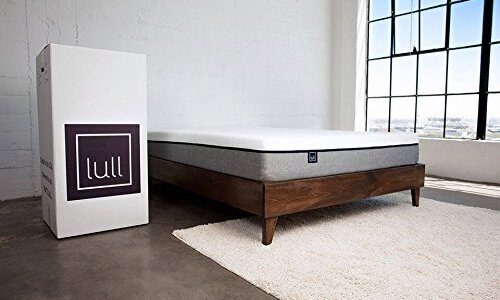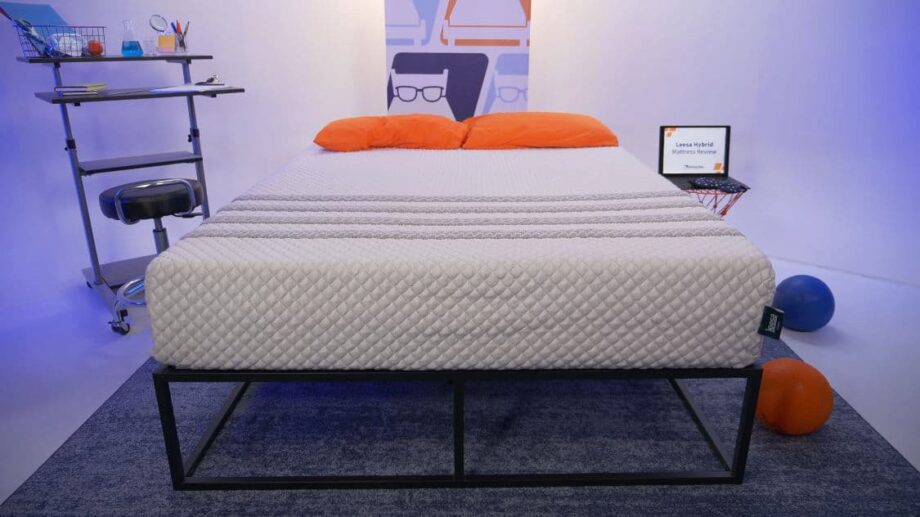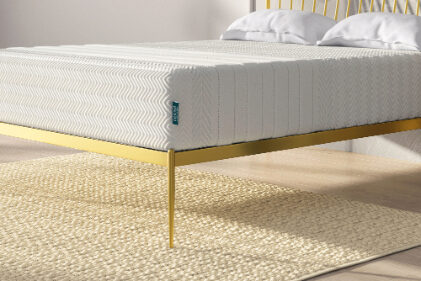Product
Firmness
Score

Disclosure: By clicking on the product links in this article, Mattress Nerd may receive a commission fee at no cost to you, the reader. Read full disclosure statement.
In this article, the Nerds uncover more about the differences and similarities between the Lull and Leesa mattresses. We compare them in terms of construction, feel, and price points so that you can clearly determine which is right for you. Check out what others are saying in our testing methodology.


The Leesa and the Lull are both bed-in-a-box foam mattresses with a medium feel. The beds are very similar, so the right mattress for you will come down to a few minor differences.
| Leesa is best for… | Lull is best for… |
| Budget shoppers | People on a very tight budget |
| People who like a neutral foam feel | Back Sleepers |
If we have a video for this comparison, write 1–2 sentences introducing what the viewer can expect from watching the video.
In this section, you’ll learn more about the different firmness and feel between the Leesa and Lull mattresses.
The Leesa is considered a true medium-soft mattress, it is a good middle ground—not too soft and not too firm. The Leesa’s firmness and all-foam construction are best for those under 230 lbs. Meanwhile, Lull is a medium-firm mattress that leans slightly towards firmness. Its foam does a great job contouring to the body so the Lull mattress relieves pressure and keeps the spine aligned while still being durable.
The Leesa mattress has a balanced feel that’s a cross between the conforming feel of memory foam and the bouncy feel of latex—its top layer has a lot of bounce and responds quickly to your movements. The Leesa is soft to the touch at first but you won’t sink too much. In contrast, the memory foam of the Lull mattress hugs your body that will leave you feeling supported and lightly contoured, making it a great option for back sleepers.
The Leesa will be enjoyed by most lightweight and average-weight sleeper side sleepers, thanks to three layers of premium memory foam that is designed to relieve pressure and contour to your curves. Similarly, the Lull is an all-foam mattress that has minimal motion transfer so it is ideal for couples—with the Lull mattress, your sleep won’t be interrupted by your partner tossing and turning at night.
Leesa Performance By Body Type & Sleeping Position:
| Body Type: | BACK SLEEPERS | STOMACH SLEEPERS | SIDE SLEEPERS |
| Lightweight (< 130 lbs): | 5 | 4 | 4 |
| Average-weight (130–230 lbs): | 5 | 3 | 3 |
| Heavyweight (> 230 lbs): | 2 | 1 | 2 |
Lull Performance By Body Type & Sleeping Position:
| Body Type: | BACK SLEEPERS | STOMACH SLEEPERS | SIDE SLEEPERS |
| Lightweight (< 130 lbs): | 5 | 3 | 3 |
| Average-weight (130–230 lbs): | 5 | 3 | 4 |
| Heavyweight (> 230 lbs): | 3 | 2 | 4 |
With a medium firmness level, average-weight back sleepers will find the Leesa mattress to excel at supporting and maintaining spine alignment. Similarly, average-weight stomach sleepers will receive enough support to sleep comfortably. Average-weight back sleepers and side sleepers will also feel wonderful on the Lull mattress as it provides superior support and contouring.
The Leesa and the Lull are not suitable beds for heavyweight stomach sleepers, back sleepers, and side sleepers. Heavyweight folks may feel discomfort and will not get the support they need from either mattresses.
Lightweight back sleepers will comfortably sleep and receive proper support on the spine and neck on the Leesa mattress. The Lull mattress will also work great for lightweight combination sleepers thanks to its medium-firm mattress that provides just the right amount of pressure relief.
Introductory sentence addressing whether the mattresses have similar or different constructions, including mattress height.
| Leesa Mattress Materials | Lull Mattress Materials |
| Rayon blend cover | Breathable Mattress Cover |
| “1.5” gel memory foam | Gel Memory Foam (“1.5”) |
| “1.5” polyfoam-latex blend | High-Resilience Foam (“1.5”) |
| “7” high-density polyfoam | Durable Base Layer (“7”) |
| “10” |
The Leesa mattress has a soft twill fabric cover while the Lull mattress uses a breathable mattress cover.
The Leesa’s comfort layer is called the “LSA200 foam—it is designed to mimic the responsive feel of latex. Designed for minimal motion transfer, the Lull’s comfort layer is gel memory foam.
Leesa’s support layer is made up of a dense polyfoam that is designed to withstand years of everyday use. The support layer of the Lull mattress is made of a durable base foam for added support.
| Size | Leesa Prices | Lull Prices |
| Twin | $849.00 | $755.00 |
| Twin XL | $899.00 | $799.00 |
| Full | $1099.00 | $1099.00 |
| Queen | $1299.00 | $1199.00 |
| King | $1599.00 | $1699.00 |
| California King | $1599.00 | $1699.00 |
For exclusive discounts on both beds see our Leesa mattress coupons and Lull mattress coupons.
The Leesa mattress adapts to all sleep positions and most body types. With its cooling foam and additional layers that both hug and support you, it’s no wonder customers love sleeping on their Leesa.
Lull offers a well-rounded mattress with a thoughtful design that addresses the typical issues with traditional mattresses. Expect temperature regulation, advanced support, good motion isolation and lasting durability.
The Leesa mattress sleeps a little cooler—the LSA200 foam in its comfort layer isn’t as prone to body heat absorption as the memory foam used in the Lull’s comfort portion.
Both the Leesa and Lull beds have low motion transfer—you shouldn’t feel your partner moving around or getting up during the night. The LSA200 material in the Leesa is slightly responsive, so if you’re ultra-sensitive, you may feel a little motion on it. The Lull, on the other hand, should be ultra-quiet and still.
The Leesa and the Lull have decent edge support. This is common for all-foam beds because they don’t have coils, springs, or high-density foam encasements to prevent the perimeter from sinking under pressure.
The Leesa and the Lull balance pressure relief and support nicely without overdoing it in either direction. Both mattresses cushion the body and distribute body weight evenly. The Lull is just barely softer than the Leesa, and the top layer of memory foam will give you just a hint of the “sinking in” sensation that some sleepers find comfortable.
The contouring layer of memory foam in Leesa should help prevent pain in key pressure points like hips and low back, particularly for lightweight to average-weight side sleepers. The Lull is designed to provide optimal spine alignment since it is made of high-quality gel memory foam.
The Leesa and the Lull should last about as long as most foam beds (seven to 10 years), but we anticipate that the Leesa will last longer because it’s a little firmer and contains a more responsive, latex-like foam in the top layer that isn’t as prone to indentations.
The Leesa Original mattress offers free shipping to all 50 states. Once it arrives, you’ll have a 100-night sleep trial period to test the mattress at home. The mattress is backed by a 10-year warranty that protects against indentations deeper than 1”, physical flaws that cause cracking or splitting, and flaws in the seams and cover.
The Lull mattress also offers free shipping if you live in the contiguous U.S. Once you receive the Lull, you’ll have a 365-night trial, or a full year, to test it at home. If you keep the Lull, it’s covered by a limited Lifetime warranty.
This luxury Sapira Hybrid mattress by Leesa combines supportive coils with premium foam for cradling and comfort. The foam is perforated to reduce heat trapping, and the coils provide excellent edge support.
We recommend this mattress for the following sleeper types: Financing options are available for this mattress. This luxury Sapira Hybrid mattress by Leesa combines supportive coils with premium foam for cradling and comfort. The foam is perforated to reduce heat trapping, and the coils provide excellent edge support.
We recommend this mattress for the following sleeper types: Financing options are available for this mattress. This luxury Sapira Hybrid mattress by Leesa combines supportive coils with premium foam for cradling and comfort. The foam is perforated to reduce heat trapping, and the coils provide excellent edge support.
We recommend this mattress for the following sleeper types: Financing options are available for this mattress.Leesa Sapira Hybrid Mattress

Material
Hybrid
Trial Period
100 nights
Shipping Method
Free shipping
Firmness
Medium-firm: 6/10
Warranty
10-year warranty
Price Range
$$$$$
Hot Sleepers
If you often overheat while you sleep, this mattress should help you stay cool.
Back Sleeping
Ideal for lightweight, average weight, and heavyweight back sleepers.
Side Sleeping
Ideal for lightweight, average weight, and heavyweight side sleepers.
Financing Options
Leesa Sapira Hybrid Mattress

Material
Hybrid
Warranty
10-year warranty
Firmness
Medium-firm: 6/10
Shipping Method
Free shipping
Trial Period
100 nights
Price Range
$$$$$
Hot Sleepers
If you often overheat while you sleep, this mattress should help you stay cool.
Back Sleeping
Ideal for lightweight, average weight, and heavyweight back sleepers.
Side Sleeping
Ideal for lightweight, average weight, and heavyweight side sleepers.
Financing Options

Leesa Sapira Hybrid Mattress
Material
Hybrid
Firmness
Medium-firm: 6/10
Trial Period
100 nights
Warranty
10-year warranty
Shipping Method
Free shipping
Price Range
$$$$$
Hot Sleepers
If you often overheat while you sleep, this mattress should help you stay cool.
Back Sleeping
Ideal for lightweight, average weight, and heavyweight back sleepers.
Side Sleeping
Ideal for lightweight, average weight, and heavyweight side sleepers.
Financing Options
The Leesa Legend is an upgraded take on the hybrid mattress. Considered a luxury hybrid mattress, it features two sets of coils for added support, topped with cradling foam and an organic cotton cover.
We recommend this mattress for the following sleeper types: Financing options are available for this mattress. The Leesa Legend is an upgraded take on the hybrid mattress. Considered a luxury hybrid mattress, it features two sets of coils for added support, topped with cradling foam and an organic cotton cover.
We recommend this mattress for the following sleeper types: Financing options are available for this mattress. The Leesa Legend is an upgraded take on the hybrid mattress. Considered a luxury hybrid mattress, it features two sets of coils for added support, topped with cradling foam and an organic cotton cover.
We recommend this mattress for the following sleeper types: Financing options are available for this mattress.Leesa Legend Mattress

Material
Hybrid
Trial Period
100 nights
Shipping Method
Free shipping
Firmness
Medium-firm: 6/10
Warranty
10-year warranty
Price Range
$$$$$
Back Sleeping
Ideal for lightweight, average weight, and heavyweight back sleepers.
Side Sleeping
Ideal for lightweight, average weight, and heavyweight side sleepers.
Financing Options
Leesa Legend Mattress

Material
Hybrid
Warranty
10-year warranty
Firmness
Medium-firm: 6/10
Shipping Method
Free shipping
Trial Period
100 nights
Price Range
$$$$$
Back Sleeping
Ideal for lightweight, average weight, and heavyweight back sleepers.
Side Sleeping
Ideal for lightweight, average weight, and heavyweight side sleepers.
Financing Options

Leesa Legend Mattress
Material
Hybrid
Firmness
Medium-firm: 6/10
Trial Period
100 nights
Warranty
10-year warranty
Shipping Method
Free shipping
Price Range
$$$$$
Back Sleeping
Ideal for lightweight, average weight, and heavyweight back sleepers.
Side Sleeping
Ideal for lightweight, average weight, and heavyweight side sleepers.
Financing Options
Truth be told, the differences between these online mattresses are minor, so the right one for you comes down to the details. As a reminder, they have similar firmness levels, are priced similarly, suit a variety of sleeping positions, and can work for couples.
We recommend the Lull if you want the lowest price point of the two and like a hint of memory foam. We recommend the Leesa if you like a truly neutral foam feel and don’t mind paying a couple hundred extra dollars to get it.
The Leesa is an excellent medium-firm mattress at an affordable, mid-range price point. With an all foam construction that supports your body as you sleep, the Leesa works well for any sleeping position. Plus, trying the Leesa is risk-free with a 100-night sleep trial.
Nope! You don’t have to worry about that with the Lull as it isn’t designed to be flipped. If you sleep with a partner and there is a significant difference in weight between the two of you, then Lull recommends rotating the mattress every few months.
We expect your Leesa mattress to last around seven years before showing signs of wear and tear. To get as many years of use as possible, it’s essential to care for your mattress—keeping it clean and setting it up on a supportive base or bed frame.